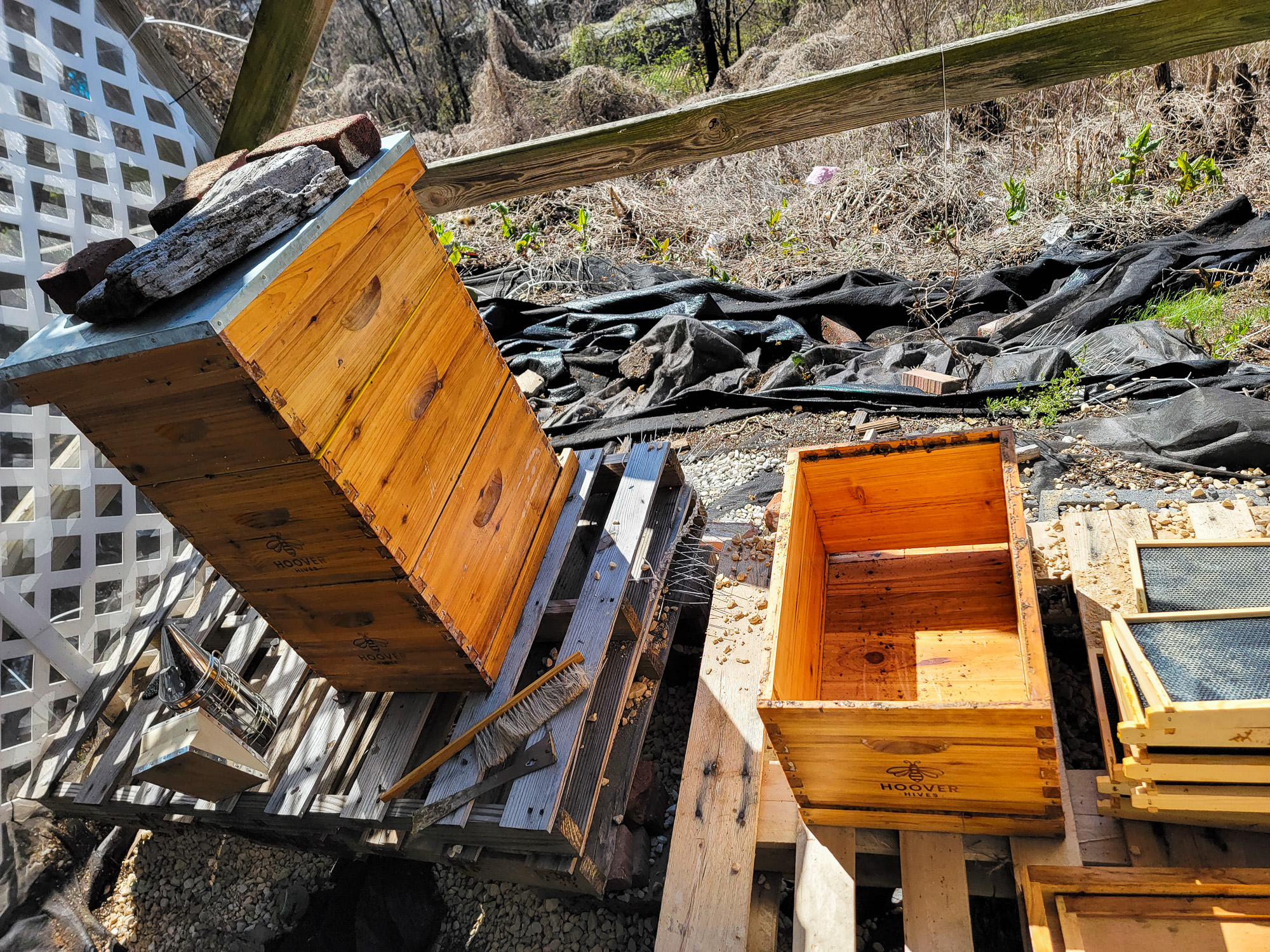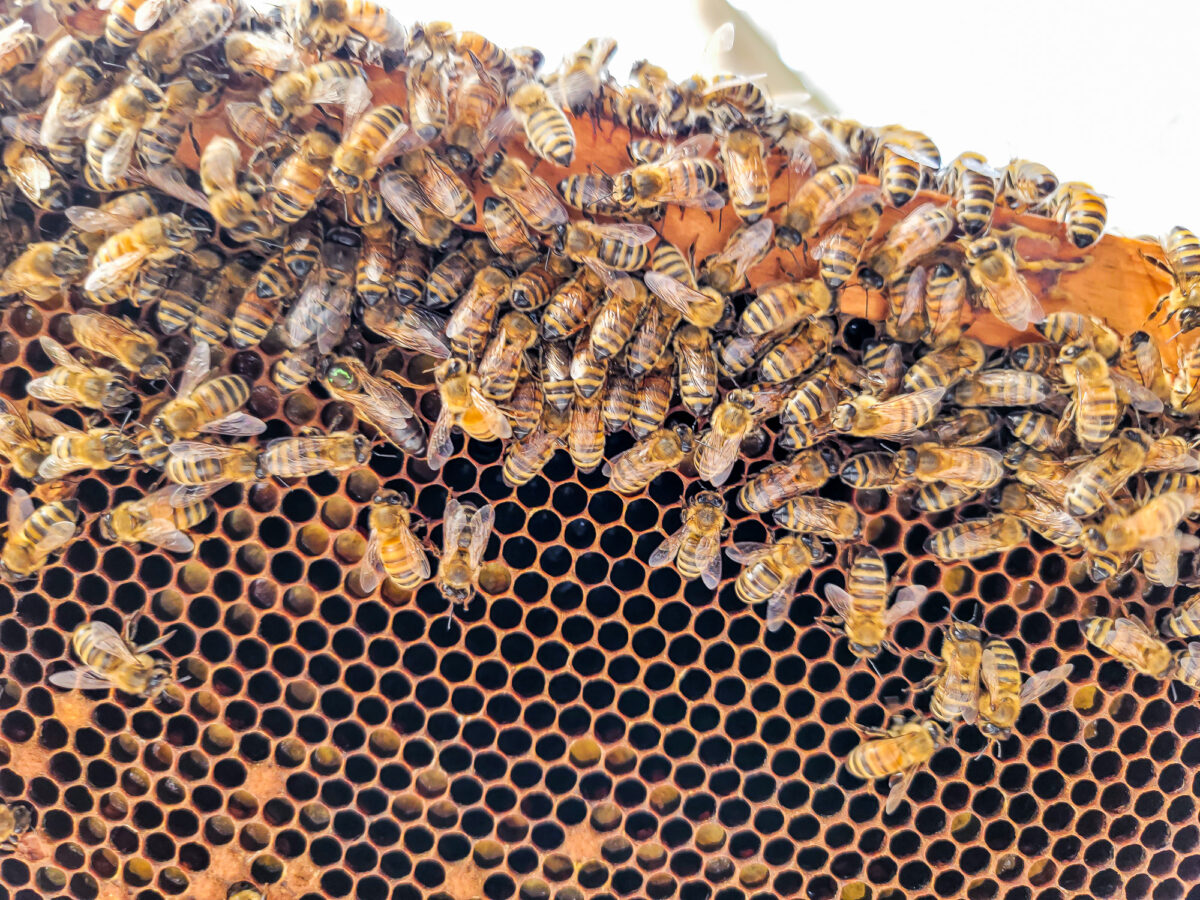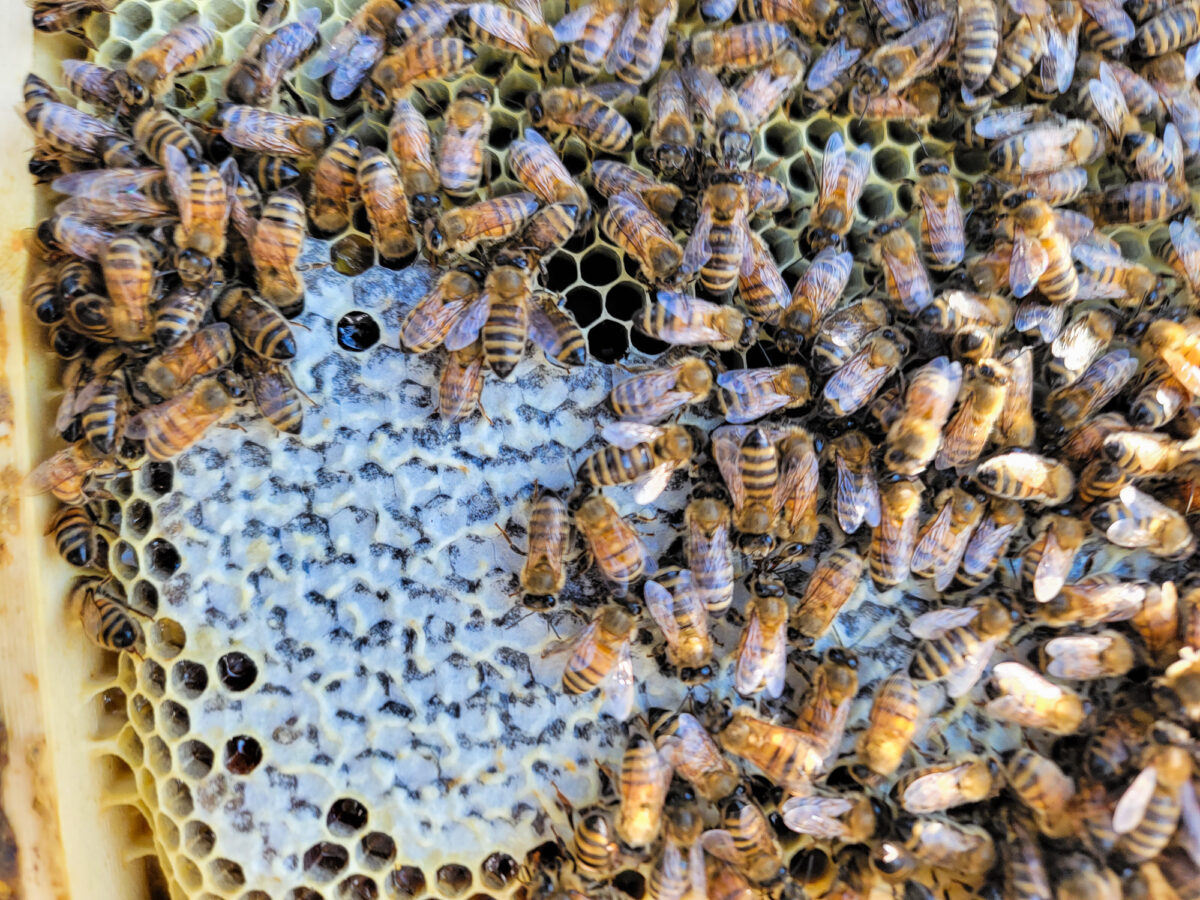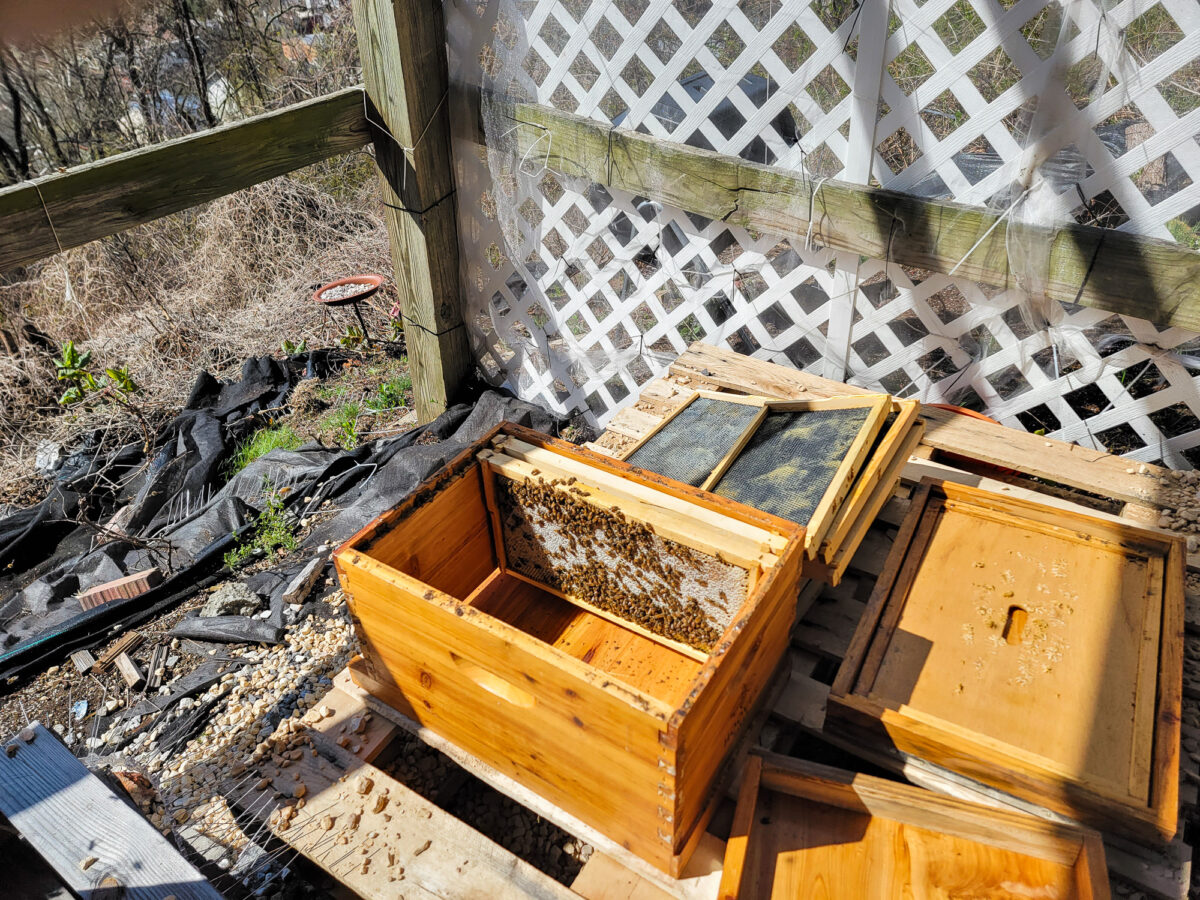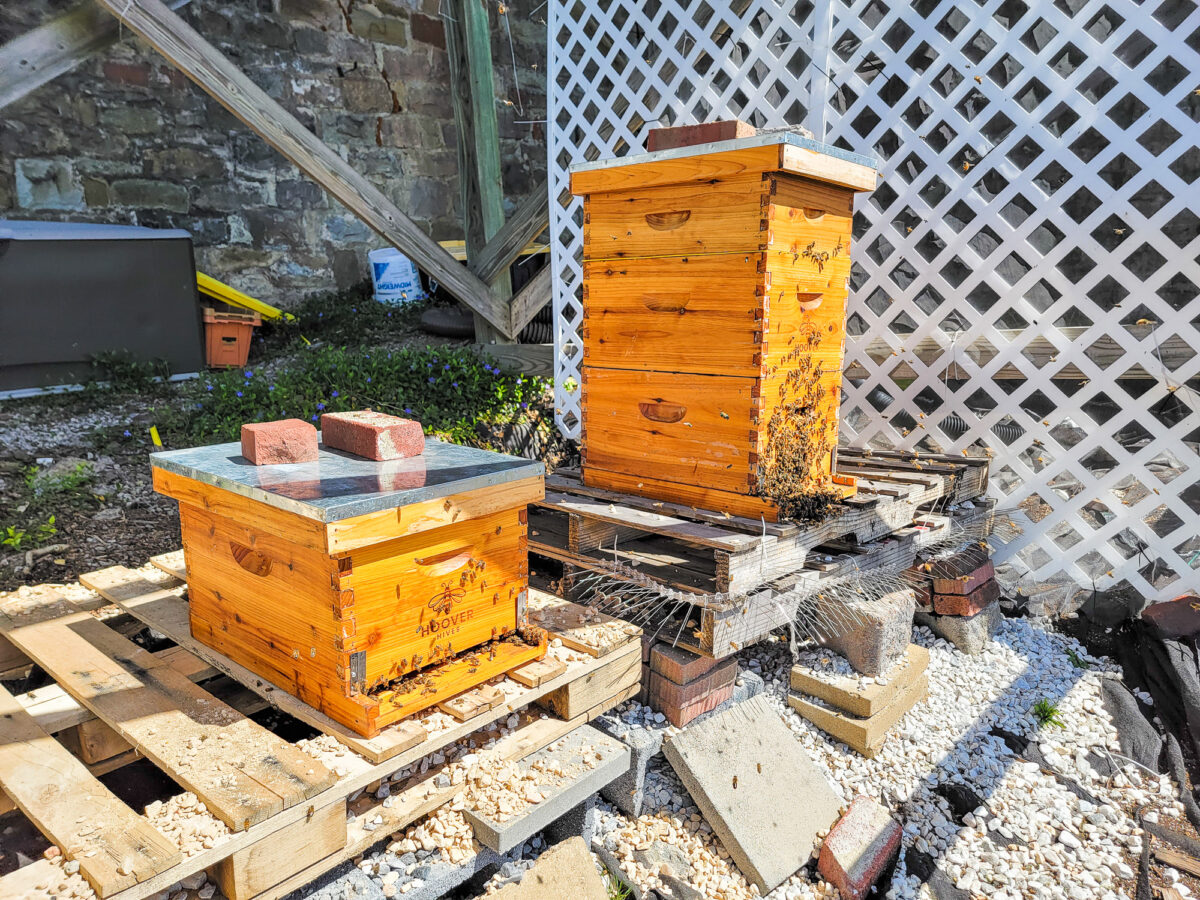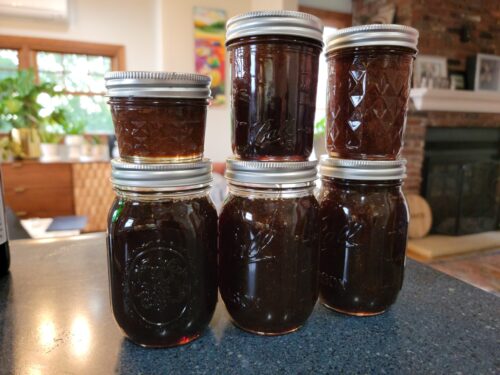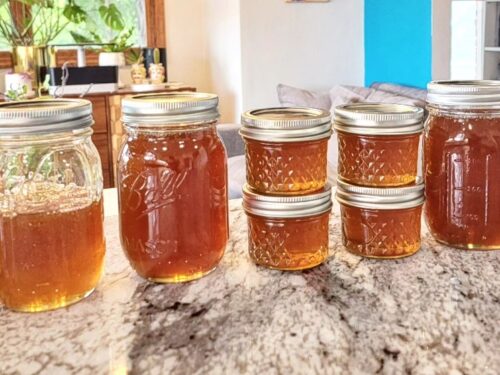Disclaimers: Our site uses demographic data, email opt-ins, display advertising, and affiliate links. Please check out our Terms and Conditions for more information.
If your beehive is growing and showing signs of swarming, or perhaps you want to grow your apiary and turn one hive into two, it is time to make a beehive split.
While there are many ways to deal with swarm management and split hives, we love the easy walkway split method as it is simple, has a fair bit of success, and requires minimal intervention on our part.
So in this one, we thought we'd tackle what a split is, why you may want to do it, and why you may have to do it.
Why Do You Split a Bee Hive?
A beehive split is simply taking one beehive and turning it into two. This involves taking frames of eggs, larva, and capped brood, frames of honey and pollen, plus bees and the queen from an existing hive and moving them to a new one. The hive with the queen begins laying eggs to build a new colony while the now-queenless hive rears a new one to recover.
When done correctly, a split allows you to start a second hive in just a few simple steps.
But why would you maybe want to do this? Well, the obvious one, as noted above, is simply to start a second hive. Another reason may be mite control as a hive becoming queenless interrupts the brood cycle, which could reduce your mite count to a degree. Another may be that you want to sell your own nucleus colonies to other beekeepers for profit. These are just a few examples.
Ultimately, most apiaries conduct splits as a swarm management technique. While the above reasons may be considered optional, depending on your situation, this is likely necessary.
When bees come out of winter hibernation, they tend to outgrow their space and then become compelled to leave and find a new, larger home. The process here is known as swarming. When this happens, the queen and a good chunk of your bees (could be half, could be almost all of them) leave your hive in search of more space. The remaining bees could survive, rear a new queen, and regain the hive successfully- but many do not.
As such, splitting a bee hive in anticipation of the start of a swarm event is a potential way to keep your bees within your hives, grow your apiary for free, and get them back to doing what they do best- making and storing honey!
How to Perform a Split – Methods and Logic
While there are an untold number of methods out there for performing a bee hive split, there are three techniques that I find the most interesting that you may want to consider- all variants of the popular walkaway split.
A walkaway split is more-or-less what the name implies- you split frames into a new hive, walk away, and let the bees rear a new queen as they do naturally in the wild.
The process here is simple, albeit with a few caveats. When you set up a new hive, ideally either within just a few feet of your old one or several miles away, you take a minimum of five frames (up to half) from your overwintered hive and put them in a new hive box, close it up, walk away, and let the bees do what they do best.
These frames should contain a mix of capped honey for food, visible pollen, eggs, larvae, capped brood (some with drone cells, too), and, ideally, the queen to get the colony going.
There are a few key elements you should do to have the best chance of success here:
- The consensus is it is best to find the queen and move her into the new hive. This mimics a swarm event as the queen and some bees have effectively left the old hive into a new one.
- The old hive then goes into a queen-rearing mode, and this period of brook break generally stops bees from wanting to swarm during the season.
- A period of brood break is also thought to help control the mite population to a small degree.
- If you are not doing a true 50/50 split, your new hive may become weaker as a result. Having the queen reside in this hive lets new eggs be laid starting on Day 1 while the older, likely more established hive has a few weeks of lag while replacing her.
- If your original hive has swarm cells on the bottom of a frame, you may want to leave a few, if not all, of those in the now-queenless hive. One of these will likely have a new queen emerge and cut off some time before laying resumes since your bees won't have to start from scratch.
- Bees tend to make swarm cells on the bottom of frames when they are outgrowing their space and are getting ready to swarm. Many beekeepers use this as a sign that a split should be performed.
- When transferring bees to the new hive, if your box is set up in the same orientation within a few feet of the original, your foragers will likely return to the original hive via hive drift. Nurse bees (younger bees that do not forage) remain and tend to the colony until they become foragers. Here, it is recommended to shake a few additional frames worth of bees into the new hive to ensure an adequate supply of nurse bees for hive health at the start. Foragers may fly back to the original, but you are loading your new hive up with ample bees.
- There are advanced methods some beekeepers do to try and get all of the bees to orient to a new hive, such as blocking the entrance for a day or two, angling the hive in a different direction, or masking the entrance with sticks to force the bees to re-orient- we have not tried these yet to comment.
- Some beekeepers also think that having the queen in the new hive is enough to entice many bees to stick around as hive activity is tied to the queen's pheromones. That said, be aware of hive drift if your hives are placed immediately next to each other!
In theory, the new hive with the queen should start recovering quickly (although feed them sugar via a feeder and pollen if you have it- the nurse bees won't be foraging for a little bit), and the old hive will attempt to rear a new one. Three to four weeks later, you may see signs of a new queen present in the original hive and, if all goes well, you now have two happy hives!
That is it for the walkaway split!
But there are a few cases worth noting here, specifically around whether you can find your queen to begin with. This is where some of the special variants of the walkway split come into play.
First, if you find your queen during the split and move her to the new hive, you are in luck. This is generally considered the optimal case. Now that you know which hive is queen-right and which one is queen-less, you can leave the queen-less hive alone for three to four weeks, let them rear a queen, and check back later to see if they were successful. (If they were not, you could always move frames of larva over from another hive to try again, or purchase a queen locally to add to the hive.)
Second, if you can't find the queen, something I am terrible at doing, you have some decisions to make as some risks are involved. The first risk is not getting the queen when you move frames into your split. The new hive may be queen-less and starting weak, whereas the original hive may be queen-right and could still risk having a swarm as there is no break in the brood cycle to inhibit this process. Some say this is okay despite the risk, others say this is a terrible idea that should be avoided at all costs.
I've yet to try leaving the queen in the old hive, but I have to admit that this seems like a risk best left as a worst-case scenario only.
If you set up a split and do not know which hive has a queen, you may want to return to the hive after 3-5 days and try and spot the queen again or, as a proxy, signs of her presence in the form of new eggs. If she is in the new hive, great, you got lucky! If she is in the old hive, you may need to investigate further and see what the next best step is- trying to find her again, perhaps adding more eggs from the old hive to the new, transferring nurse bees, buying a queen for the new hive and risking a swarm in the old one, etc.
- We cannot recommend what to do at this step yet as there are several options, none of which are ideal. So you may have to stop and think about the best path forward, and their risks, all the same. The ideal case is, in all honesty, getting the queen into the new hive.
If you go into your hive to begin a split and cannot find the queen at all and there are no signs that the hive may swarm at any moment (capped queen cells on the bottom of frames are a good indication a swarm may be imminent- open ones may indicate you have a few days), there is one trick that could help you identify the queen easier- or at least, her location.
This method works best for those with two brood boxes and want to perform a true 50/50 split. When inspecting your hives, all you need to do is add a queen excluder between the two hive boxes. The bees will orient themselves between the two boxes, with a mix of nurse bees, foragers, and drones, while the queen will be effectively trapped inside one section. Return in 3-5 days, check for signs of new eggs in each box, and the box that has new eggs is where the queen (likely) is.
Whichever box has signs of your queen should be moved to become the new colony in the split, and since you now know the queen should be in that box, she goes along with it. Easy!
The risk here is ensuring that the box your queen is in has enough resources (honey/pollen) and capped egg cells to grow, as you are now no longer equalizing the two hives as you would on a traditional walkaway split. However, if you are worried about this risk, you may want to consider reorganizing frames before adding the queen excluder to equalize resources between the two boxes. A few extra minutes of work could go a long way to split success here.
A final option to consider is buying a queen from a local source, adding her into the queenless hive during (or after a split, once identified), and moving on. This may not help swarm prevention as much, especially if the original queen remains in the original hive post-split, but it is a simple way to make your hives queen right for a little bit of money and without the 4+ week delay and potential risks of colony collapse that are associated with it. The hives can get back to work immediately, start building up honey, and, with any luck, don't swarm.
- If you go this route, you may need to embrace other techniques for swarm management here, like removing queen cells as they're built, adding another deep for space, etc. We do not have guides to these, but we are just noting them because additional steps will need to be applied.
In my first split, I could not identify the queen, and I did not know which hive she was in until checking a few days later. I moved the queen then and everything seemed okay in the end. I will likely try the queen excluder between hive boxes technique in the future simply because the odds of success are so much greater. As you are likely going to be looking at every single frame trying to find your queen (unless you're lucky), the extra step of adding the excluder isn't that much extra work- open your boxes, equalize resources, add the excluder, and return in a few days to split!
While I likely cannot guarantee with 100% success that the queen will be in the box I move, if the signs are present that the queen is there, the odds are likely close enough for most.
Ultimately, these are some starting points to consider whether you are splitting a beehive to grow your colonies, as a swarm prevention technique, or for another reason altogether. This is not a comprehensive list simply because every beekeeper has a favorite that works best. As with everything, what works for one beekeeper may be something another swears against completely. What I think may be a good idea, another beekeeper may think is terrible. I could go on.
While I don't believe that there is a one-size-fits-all answer for swarming, and no split technique has a 100% guarantee of success, you need a starting point to get going. You may follow tips you read online and succeed. You may try tips and fail. This is all part of the learning process and finding what works best for you, your bees, and your apiary.
Do you have a favorite method for a beehive split? Comment below to share!
Start an Apiary Today
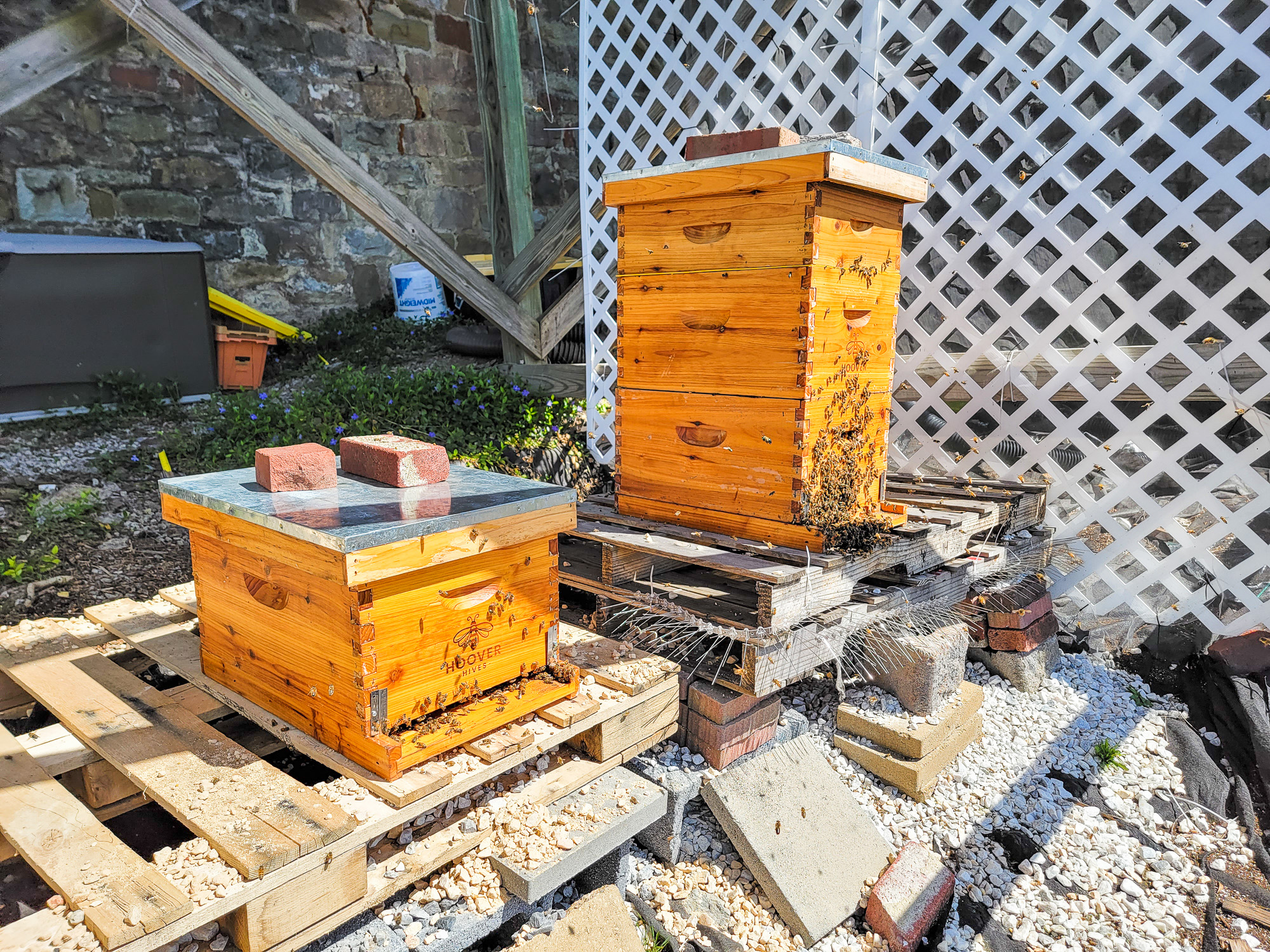
Looking to get into beekeeping? Pick-up preassembled waxed Hoover Hives from Galena Farms. Use discount code HIPSTERHOMESTEADERS to take 5% off your order!

